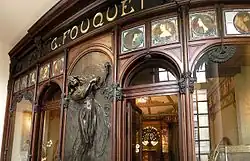Georges Fouquet

Georges Fouquet (1862–1957) was a French jewelry designer best known for his Art Nouveau creations.[1] He was part of a successful jewellery family;[2] his father Alphonse Fouquet designed in a neoclassicist style, and his son Jean Fouquet designed in the Art Deco style.
Career
In Paris, Fouquet joined his father in the family business in 1891.[1] He took over the running of the company in 1895.[3] In 1900, he opened a new jewelry shop at 6 rue Royale in Paris, designed by the illustrator Alphonse Mucha.
In 1900, Fouquet was featured at the Exposition Universelle in Paris.[4] His collaboration with Mucha was prominently showcased, unveiling a highly theatrical line of jewelry characterized by intricate enamel work, natural motifs, and the innovative use of materials like ivory, mother-of-pearl, and gemstones. This collection became an iconic representation of the Art Nouveau style.[5][6]
Fouquet was a fantasist, and while his creations can be associated with the Lalique school, it is not due to imitation, but rather his imaginative talent. His work is often complex and holds a foremost place in the Art Nouveau movement.[7] Contrary to Lalique but like Henri Vever, Fouquet expressed himself through more synthetic geometric forms.[8][9]
He also designed jewels for French actresses such as Sarah Bernhardt.[8] His work can be found at the Metropolitan Museum of Art,[10] the Victoria and Albert Museum,[11] the Petit Palais.[12] The interior of Fouquet's shop is preserved at the Carnavalet Museum in Paris.[13][14] In 1984, a major exhibition of three generations of the Fouquet Jewellers was made by the Musée des Arts Décoratifs, Paris; the exhibition was then shown at the Rietberg Museum in Zurich.[2]
References
- ^ a b Staff writer. "Biography for Georges Fouquet". Birmingham Museums & Art Gallery. Archived from the original on 23 December 2015. Retrieved 23 December 2015.
- ^ a b de Gary, Marie-Noël (1984). Les Fouquet: Bijoutiers & Joailliers a Paris 1860-1960 [The Fouquet: Jewellers of Paris 1860-1960] (in French and German) (Musée des arts décorative (France) ed.). France: Musée des arts décorative (France), Flammerion. ISBN 9782080120199.
- ^ "- Biography - Birmingham Museums & Art Gallery Information Centre". www.bmagic.org.uk. Retrieved 2024-10-18.
- ^ Staff writer. "Georges Fouquet (1858-1929), Paris, after design by Mucha: Ornamental Chain with pendants (1900)". Mucha Foundation. Archived from the original on 5 March 2016. Retrieved 23 December 2015.
- ^ Misiorowski, Elise B.; Dirlam, Dona M. (1986-01-01). "Art Nouveau: Jewels and Jewelers". Gems & Gemology. 22 (4): 209–228. doi:10.5741/GEMS.22.4.209. ISSN 0016-626X. S2CID 67802910.
- ^ "Exploring the Fascinating World of Art Nouveau Jewelry Collecting". DSF Antique Jewelry. Retrieved 2024-10-18.
- ^ Holme, Charles (Jul 31, 2015). "Modern Design in Jewellery and Fans". Gutenberg. Retrieved 2024-10-29.
- ^ a b Staff writer. "Georges Fouquet French artisan". Britannica. Archived from the original on 23 December 2015. Retrieved 23 December 2015.
- ^ Staff writer. "Georges And Jean Fouquet". Primavera Gallery. Archived from the original on 24 December 2015. Retrieved 23 December 2015.
- ^ Staff writer. "Dress ornament, 1923, Georges Fouquet (French, 1862–1957)". The Metropolitan Museum of Art. Retrieved 23 December 2015.
- ^ Staff writer. "Brooch". Victoria and Albert Museum. Archived from the original on 24 December 2015. Retrieved 23 December 2015.
- ^ Staff writer. "Georges Fouquet". Verbinina. Archived from the original on 23 December 2015. Retrieved 23 December 2015.
- ^ Staff writer. "Boutique Bouquet: Installation of a space representing the interior designed by Mucha, Musée Carnavalet". Retrieved 23 December 2015.
- ^ Staff writer (14 February 2013). "Alphonse Mucha's Jewelry Shop at the Musée Carnavalet". Untapped Cities. Retrieved 23 December 2015.